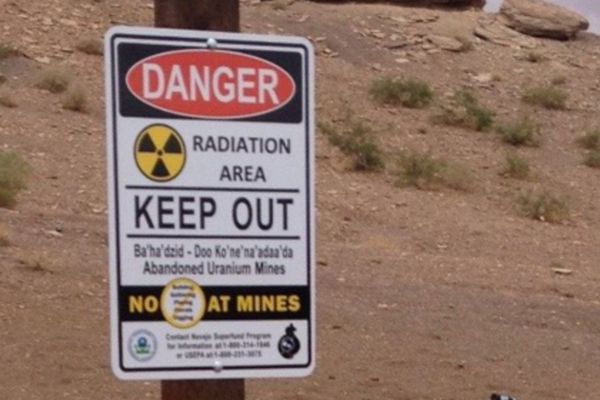
- Details
- By Levi Rickert
Uranium mining and processing have led to the release of radioactive materials and toxic chemicals that have contaminated the air, soil, and water sources in the region. Exposure to these substances has increased lung cancer rates and other critical health issues among Navajo communities. Among other diseases common among Navajo people who were exposed to high levels of radiation include other respiratory illnesses, such as silicosis, tuberculosis, pneumonia, and emphysema.
Besides contributing to deadly health-related illnesses, uranium mining and milling on the reservation had a negative effect on the Navajo culture. Uranium mining has disrupted the Navajo Nation's sacred sites and traditional cultural practices, causing significant cultural losses and spiritual harm.
The mines closed almost 40 years ago. The companies that operated the mines have left 500 abandoned uranium mines behind. Homes and water sources still have elevated levels of radiation that are still causing high levels of cancer and other respiratory diseases.
The lingering aftermath of uranium mining on the reservation has plagued Navajo leadership for decades. So, it was fitting when this summer’s blockbuster movie that has taken over $550 million, as reported on Sunday by CNN. When Oppenheimer was released three weeks ago, Navajo Nation President Buu Nygren penned an essay for TIME magazine about the lack of the Navajo uranium story in the movie.
“The Navajo people cannot afford to be, yet again, erased from history,” Nygren writes in a TIME magazine op-ed on July 21, 2023.
Nygren says the movie was released five days after the 44th anniversary of the Church Rock uranium mill spill, when 94 million gallons of radioactive waste poured into the Puerco River spanning the northern portions of New Mexico and Arizona, where the Navajo Nation is located.
“What came next—cancers, miscarriages, and mysterious illnesses—is a direct consequence of America’s race for nuclear hegemony. It’s an accomplishment built on top of the bodies of Navajo men, women, and children—the lived experience of nuclear weapons development in the United States. But, as usual, Hollywood chose to gloss over them.” Nygren writes.
Native Americans have often been left out of American history through erasure. For that reason, many Americans often think Native Americans don’t exist, as indicated in the 2018 Reclaiming Native Truth project. The project’s survey found 40 percent of respondents didn’t think Native Americans still exist.
The project aimed to determine the “dominant narrative” around Native people. So, what are people saying about Native Americans, how are they represented in culture and media, and, crucially, how does that translate into public policy and opinion?
“The complete lack of representation in the media, in pop culture, in K-12 education not only erases us from the American consciousness, it inadvertently creates a bias,” Illuminative’s President and CEO Crystal Echohawk (Pawnee) told Women’s Media Center in a 2018 interview.
“People were less likely to support certain rights and social justice issues for Native people when they had zero perception and understanding of who we are. Invisibility and erasure is the modern form of racism against Native people.”
“Oppenheimer” missed an opportunity to present the Navajo people’s contribution to the uranium story of America. But, more critically, it missed the opportunity to tell of the Navajo people’s long struggle with severe health issues as the result of Oppenheimer’s work.
The film’s failure to tell this story provides another example of why it is important for the defense of teaching Native American history to public education students, especially today in the age of the war on “wokeness.”
Thayék gde nwéndëmen - We are all related.
More Stories Like This
Tribes Do Not Need a Greenlight to Build Renewable EnergyLaw Should Not Get in the Way When "Manifest-ing Destiny"
Celebrating 35 Years of Gaming Success
My Tribe’s ICE Contract Betrayed Our Values
Extending the Affordable Care Act Is a Moral Imperative for Indian Country
Help us defend tribal sovereignty.
At Native News Online, our mission is rooted in telling the stories that strengthen sovereignty and uplift Indigenous voices — not just at year’s end, but every single day.
Because of your generosity last year, we were able to keep our reporters on the ground in tribal communities, at national gatherings and in the halls of Congress — covering the issues that matter most to Indian Country: sovereignty, culture, education, health and economic opportunity.
That support sustained us through a tough year in 2025. Now, as we look to the year ahead, we need your help right now to ensure warrior journalism remains strong — reporting that defends tribal sovereignty, amplifies Native truth, and holds power accountable.
 The stakes couldn't be higher. Your support keeps Native voices heard, Native stories told and Native sovereignty defended.
The stakes couldn't be higher. Your support keeps Native voices heard, Native stories told and Native sovereignty defended.
Stand with Warrior Journalism today.
Levi Rickert (Potawatomi), Editor & Publisher


